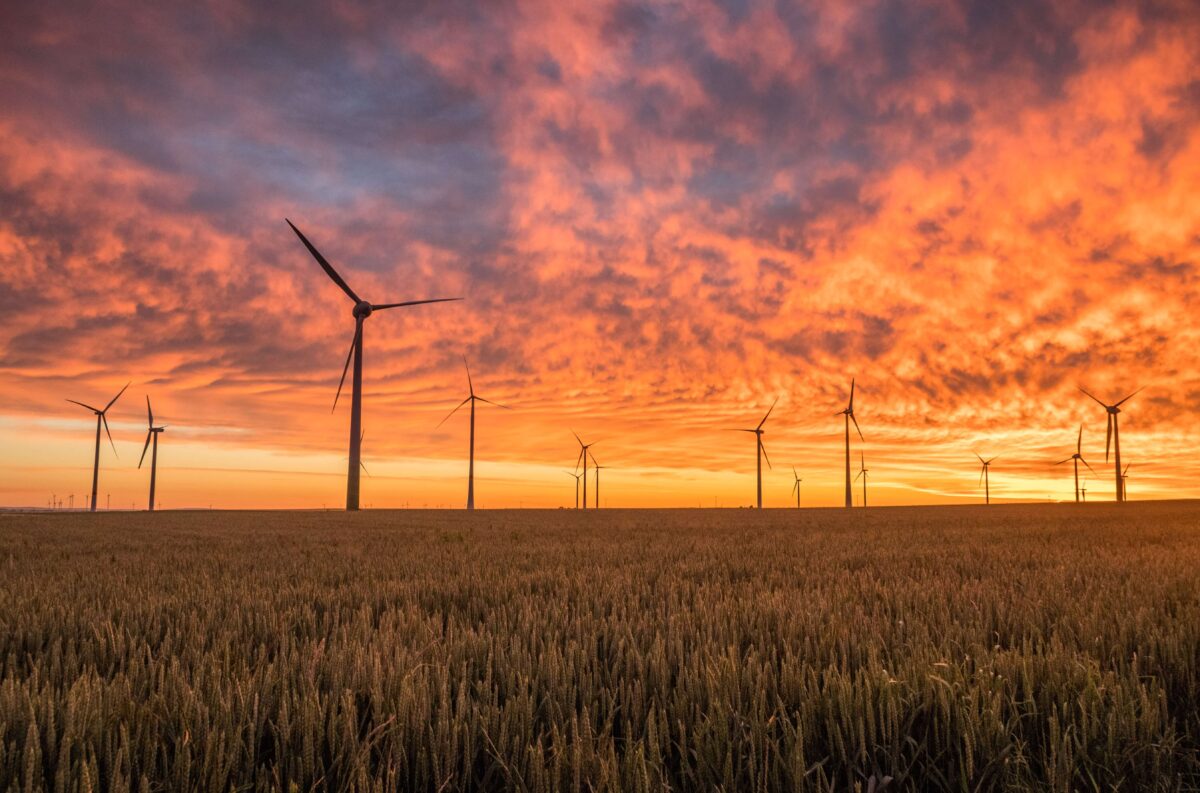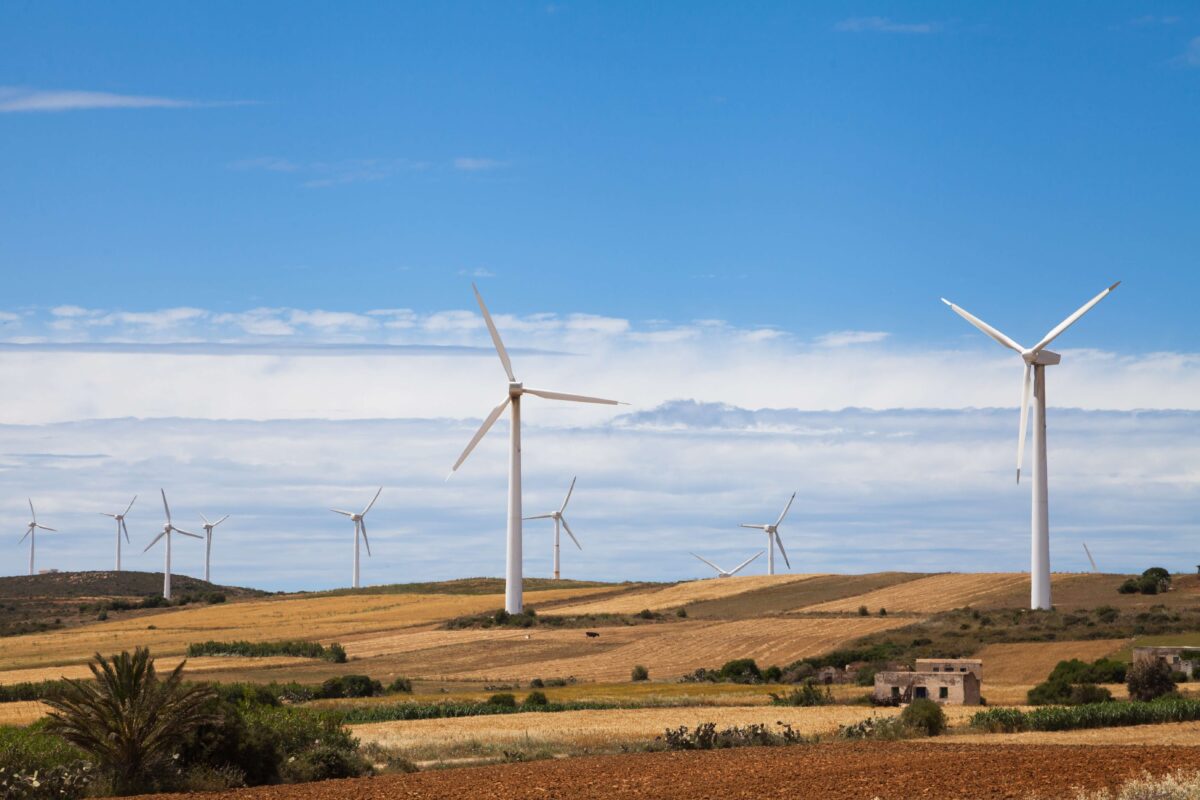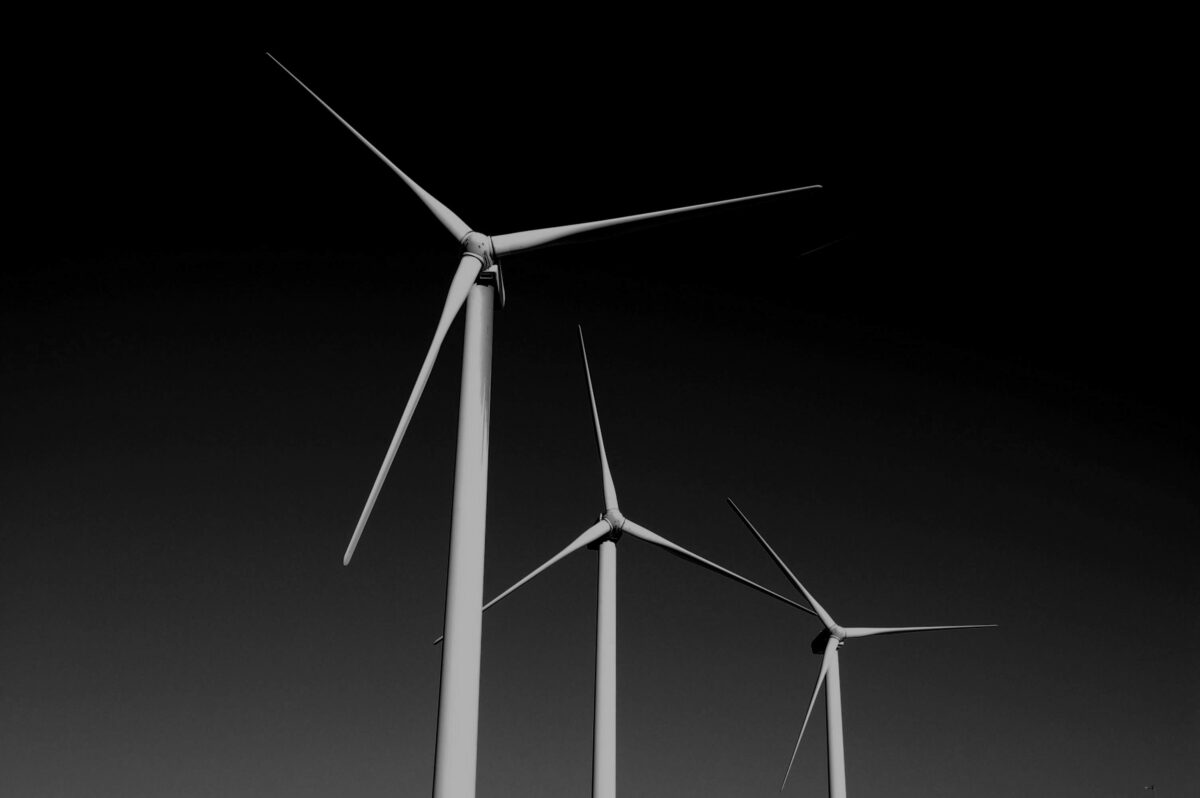November 2019: poo power!
Welcome to the November newsletter from the Oxford Martin School Programme on Integrating Renewable Energy. In this edition we feature citizen’s assemblies, the need to focus on energy as the main cause of greenhouse gas emissions, and how to power transport, the largest user of energy, from solar to poo! Please do subscribe to receive the newsletter directly!
Helen Gavin
Tackling climate change means tackling energy!
 Cities are at the forefront of implementing positive action to tackle climate change. An example is Oxford where the city council declared a Climate Emergency in January 2019, and held a Citizen Assembly over two weekends in September and October 2019.
Cities are at the forefront of implementing positive action to tackle climate change. An example is Oxford where the city council declared a Climate Emergency in January 2019, and held a Citizen Assembly over two weekends in September and October 2019.
Participants were tasked with answering the question: “should Oxford seek to achieve net zero carbon sooner than the 2050 deadline set by Government?” and explored buildings, transport, the role for renewables, biodiversity, and waste. The report setting out the proposals from the assembly is being written and hopefully will inform a new Sustainability Strategy for the city with new measures and targets.
Professor Nick Eyre from the Oxford Martin Programme on Integrating Renewable Energy gave an overview of energy issues relating to climate change. Watch this short video to find out the three key aspects Nick wants people to understand about energy and climate change.
Tackling climate change means tackling energy, as it is responsible for 84% of the UK’s greenhouse emissions. Power infrastructure is used for ~50 years and so the rate of change in the energy sector is slower than in other areas. Further, while buildings can be built or converted to zero carbon by using heat pumps and solar panels, unless they are appropriately insulated they may remain damp, drafty, and expensive to run. Given most housing in the UK was built before the second world war there must be support for appropriate energy efficiency standards, especially for rented properties.
The Climate Assembly UK
 In June 2019, six select committees of the House of Commons (Business, Energy and Industrial Strategy; Environmental Audit; Housing, Communities and Local Government; Science and Technology; Transport; and Treasury) joined together and commissioned the “Climate Assembly UK”, a citizens’ assembly on combatting climate change and achieving the pathway to net zero carbon emissions.
In June 2019, six select committees of the House of Commons (Business, Energy and Industrial Strategy; Environmental Audit; Housing, Communities and Local Government; Science and Technology; Transport; and Treasury) joined together and commissioned the “Climate Assembly UK”, a citizens’ assembly on combatting climate change and achieving the pathway to net zero carbon emissions.
In early November, 30,000 invitations will be issued and a representative sample of 110 people selected from across the UK those who reply. The assembly will run over four weekends over January to March 2020 in Birmingham.
Participants will look at how the UK will reach its net zero emissions climate target by 2050, and what members of the public can do to help reduce carbon emissions.
Decarbonising the transport sector is critical for Net Zero
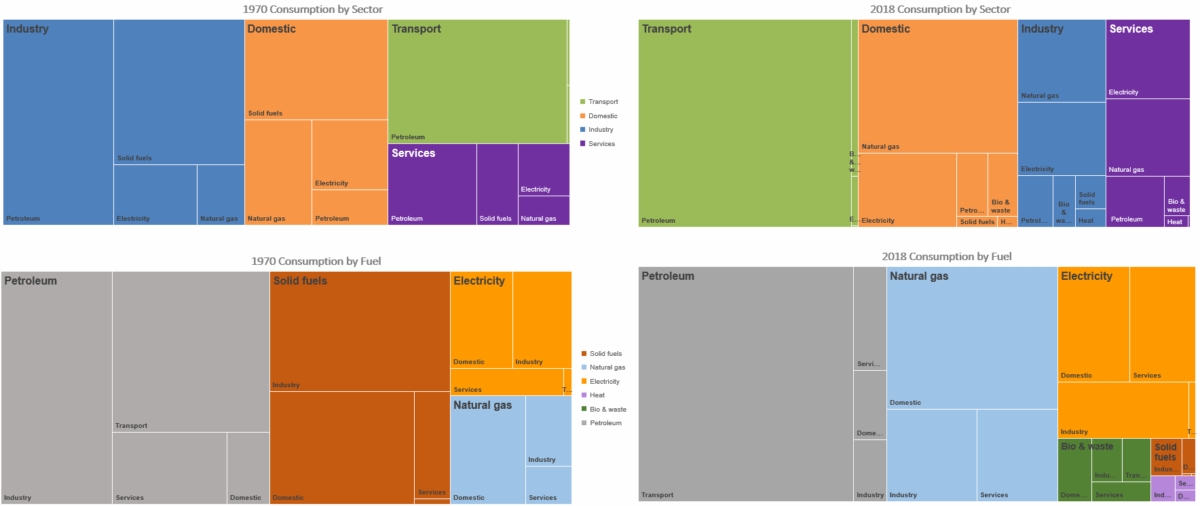 The annual publication, “Energy Consumption in the UK” (ECUK) from BEIS gives insights and analysis of energy consumption data. In its infographic above, the size of the squares represent the share of that sector or energy source to the total energy used in 1970 and 2018.
The annual publication, “Energy Consumption in the UK” (ECUK) from BEIS gives insights and analysis of energy consumption data. In its infographic above, the size of the squares represent the share of that sector or energy source to the total energy used in 1970 and 2018.
The chart shows the change over time in terms of which sector uses the most energy, with industry and domestic energy use being surpassed by transport. This is both likely due to increased efficiency of the former two sectors, but also the reduced demand due to the decline of industry and manufacturing over that time period. This highlights that when we consider the UK’s total greenhouse gas emissions, we must note where the accounting boundaries are set: arguably we should include the embodied footprint of goods that are used in the UK but not now made here.
What is striking from the energy source change over time is both the continuing dominance of petroleum, but the positive inclusion of low carbon fuels such as electricity, and bio from waste. A mix of technologies is needed to decarbonise the transport sector.
Using EVs to balance the national grid
 In September 2019, sale of battery (pure) EVs (BEVs) reached a record high, up 236% year-over-year. BEV registrations in the UK achieved their third best month ever in October 2019, up 152% compared to October 2018.
In September 2019, sale of battery (pure) EVs (BEVs) reached a record high, up 236% year-over-year. BEV registrations in the UK achieved their third best month ever in October 2019, up 152% compared to October 2018.
While the number of electric vehicles being sold has increased sharply, with many people expressing a desire to have one, for many they remain unaffordable. At least one city in the USA has found a cheaper electric car alternative: golf carts.
Buyers of new cars are private individuals, but also fleet managers including those from the emergency services. One of the reasons why fleet managers are interested is because of the opportunity to use the batteries within the vehicles for grid balancing services. This could become a potential new revenue stream when the vehicles are not being driven. Using stored renewable energy in vehicle batteries to offset peaks in electricity demand can also potentially:
![]() increase efficiency;
increase efficiency;
![]() improve energy security; and
improve energy security; and
![]() increase the number of renewable energy sources that can be plugged into the UK grid.
increase the number of renewable energy sources that can be plugged into the UK grid.
Vehicle-to-Grid Oxford is a project looking specifically at electrified delivery vehicles and exploring the practicalities and possibility of using their batteries to balance the grid, or their own building. In this short video, Katherine Collett of Oxford’s Energy Power Group, and the Programme on Integrating Renewable Energy explains more about the project which is funded by Innovate UK, and runs from 2018-2021. The project focuses on electric fleet vehicles which have a uniform schedule, and larger battery and will assess how much of the battery is normally used on regular daily use, and what potential exists for the battery to be used bi-directionally i.e. send the electricity in the battery back to the grid when needed.
is a project looking specifically at electrified delivery vehicles and exploring the practicalities and possibility of using their batteries to balance the grid, or their own building. In this short video, Katherine Collett of Oxford’s Energy Power Group, and the Programme on Integrating Renewable Energy explains more about the project which is funded by Innovate UK, and runs from 2018-2021. The project focuses on electric fleet vehicles which have a uniform schedule, and larger battery and will assess how much of the battery is normally used on regular daily use, and what potential exists for the battery to be used bi-directionally i.e. send the electricity in the battery back to the grid when needed.
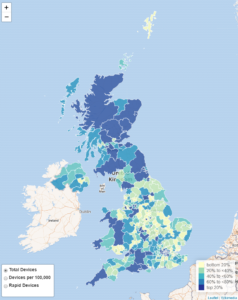 Vehicles plugged into chargers in car parks (public and workplace) could also participate in vehicle to grid schemes. There are now more public electric vehicle charge points than petrol stations in the UK: more than 10,000 locations with a total of 28,000 connectors according to Zap-Map. There has been a 53% increase in charging locations since November 2018, as shown above, with most growth seen in on-street EV charging. Supermarkets such as Morrisons and Lidl are now rolling out charging facilities to entice shoppers to their stores.
Vehicles plugged into chargers in car parks (public and workplace) could also participate in vehicle to grid schemes. There are now more public electric vehicle charge points than petrol stations in the UK: more than 10,000 locations with a total of 28,000 connectors according to Zap-Map. There has been a 53% increase in charging locations since November 2018, as shown above, with most growth seen in on-street EV charging. Supermarkets such as Morrisons and Lidl are now rolling out charging facilities to entice shoppers to their stores.
While the increase in charging locations is to be welcomed, a new ‘league table’ and map reveals that the distribution of the chargers is unequal around the county.The number of (non-Tesla) rapid chargers at motorway services stations certainly needs to be increased and their reliability improved, as currently drivers sometimes find chargers are not working or that they need to queue for the charger. Service stations with predominantly rapid chargers account for only 4% of the total.
The Transport Minister has written to local authorities, urging them to take advantage of the £400 million Charging Infrastructure Investment Fund available as part of the government’s Road to Zero strategy and prevent a postcode lottery preventing people adopting the “new normal” of EVs.
Renewably powering the railways
 The railway is a low carbon form of transport: journeys by rail comprise 11% of all distance travelled across the UK but only emit only 2.5% of total transport emissions, for both passengers and freight.
The railway is a low carbon form of transport: journeys by rail comprise 11% of all distance travelled across the UK but only emit only 2.5% of total transport emissions, for both passengers and freight.
Nevertheless, there is an ambition for the railway to become a key contributor to achieving Net Zero emissions by 2050: in 2018 the Department for Transport set a challenge for rail to remove diesel-only trains by 2040 and achieve an 80% carbon reduction on 1990 levels by 2050.
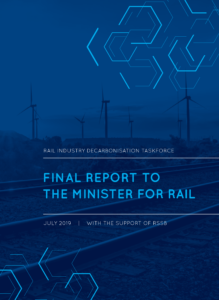 In response, the Rail Industry Decarbonisation Task Force and rail body RSSB has published a decarbonisation plan in July 2019.
In response, the Rail Industry Decarbonisation Task Force and rail body RSSB has published a decarbonisation plan in July 2019.
The report states that significant decarbonisation by 2050 is feasible, but needs a balanced approach of cost-effective electrification, coupled with targeted battery and hydrogen technology where feasible. Currently only 38% of the route km (the route available to trains) is electrified.
Passenger journeys have nearly doubled over 25 years, from 33.7 billion in 1990 to 65.8 billion in 2015. The expected increase in train passengers in the south of England, and the 2040 target, conflict with the reality of a congested grid infrastructure.
In its decarbonisation plan, the Rail Industry Decarbonisation Task Force and rail body RSSB call on government to set out a clear policy position to define its expectation of rail in delivering net zero carbon. This will enable the industry to maximise its ability to innovate and deliver against the agreed target in the most cost-effective manner. They caution that delays on decision and targets, policies and (in the next 2-5 years) vehicle procurement will have a very high probability of affecting progress towards these targets.
Some commentators call for an earlier elimination of diesel power due to the expected increase in fuel cost, and the unacceptable health risk to public and staff. They say that, as trains are in service for 40-50 years, zero-carbon trains need to be ordered and delivered from 2025 onwards to stay on track with this timeline of decarbonisation.

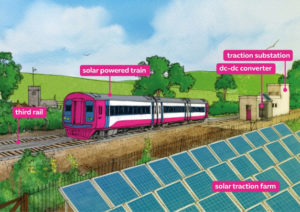 Dr Colin Noldan is a non-executive director of Community Energy South which, together with the organisation Possible, formed the company Riding Sunbeams, which has won the 2019 Community Energy Collaboration Award. This company explores and tests whether unsubsidised solar PV can be installed alongside railway lines and be connected directly to electrified railways to provide traction power for trains. The direct supply of renewable energy to rail traction systems has never before been done but would mean power can be sourced directly and cheaply, allowing the power user to bypass the grid completely.
Dr Colin Noldan is a non-executive director of Community Energy South which, together with the organisation Possible, formed the company Riding Sunbeams, which has won the 2019 Community Energy Collaboration Award. This company explores and tests whether unsubsidised solar PV can be installed alongside railway lines and be connected directly to electrified railways to provide traction power for trains. The direct supply of renewable energy to rail traction systems has never before been done but would mean power can be sourced directly and cheaply, allowing the power user to bypass the grid completely.
Dr Noldan comments that currently, the rail infrastructure uses 3.5 TWh annually and this is forecast to increase to 4.5 TWh by 2030. How can the extra energy be provided without incurring excessive infrastructure costs?
Renewably generated electricity fed directly into the local network infrastructure is the ideal but also possibly the only way to power the additional trains or services needed to meet passenger demand without putting pressure on the National Grid. Not only would this be most targeted solution providing extra energy where needed, but a direct wire supply could provide a share of the extra energy needed without additional energy expenditure on behalf of Network Rail.
 In its “First Light” project Riding Sunbeams have worked closely with Network Rail, which is one of the UK’s largest landowners and one of the UK’s biggest user of electricity. They have successfully installed a modest 350-panel solar array on land belonging to Network Rail near Aldershot, Hampshire after extensive feasibility work and research. It is thought this is the world’s first railway line to be directly powered via solar. The DC electricity generated is fed directly into a Network rail substation and powers the railway infrastructure (signals, switches, track etc). This site was chosen as it fulfilled many of the requirements needed for the set-up including land ownership, ease of access, orientation (the ability to place solar panels facing away from the track to minimise any potential reflected glare to train drivers).
In its “First Light” project Riding Sunbeams have worked closely with Network Rail, which is one of the UK’s largest landowners and one of the UK’s biggest user of electricity. They have successfully installed a modest 350-panel solar array on land belonging to Network Rail near Aldershot, Hampshire after extensive feasibility work and research. It is thought this is the world’s first railway line to be directly powered via solar. The DC electricity generated is fed directly into a Network rail substation and powers the railway infrastructure (signals, switches, track etc). This site was chosen as it fulfilled many of the requirements needed for the set-up including land ownership, ease of access, orientation (the ability to place solar panels facing away from the track to minimise any potential reflected glare to train drivers).
The project has proven that plugging solar directly into the UK railways can be done safely and without disrupting the trains. Following this success, Network Rail estimate that using renewable energy could help it achieve its cost saving target of £3.5bn over the next 5 years, and provide 10% of the energy needed to power trains on Britain’s electrified third rail routes. The approach has huge potential and can be applied to metros, trams and railways everywhere.
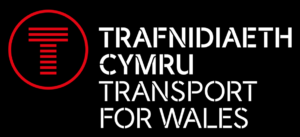 Riding Sunbeams is also working with Transport for Wales, assessing technical and procurement issues for renewable energy to optimise traction energy use on AC powered networks, in the Green Valley Lines in South Wales.
Riding Sunbeams is also working with Transport for Wales, assessing technical and procurement issues for renewable energy to optimise traction energy use on AC powered networks, in the Green Valley Lines in South Wales.
A key technical difficulty is providing overhead power through tunnels and bridges. While the actual power line can be passed through, the trains will be disconnected and will need an alternative source of power, such as flywheel or batteries. Another challenge is the number of available substations which affects the location for the solar array. Such challenges are not encountered with the alternative powering option i.e. a third rail. However, the fact that many parts of railway track are accessible to people and humans mean that the safety risk prevent further expansion of third rail.
Where there’s muck there’s brass
 Renewable fuels are produced from biomass (organic material from plants and animals) or some other renewable energy source. They are often blended with conventional fuels, but produce lower greenhouse gas emissions as their energy comes from renewable sources.
Renewable fuels are produced from biomass (organic material from plants and animals) or some other renewable energy source. They are often blended with conventional fuels, but produce lower greenhouse gas emissions as their energy comes from renewable sources.
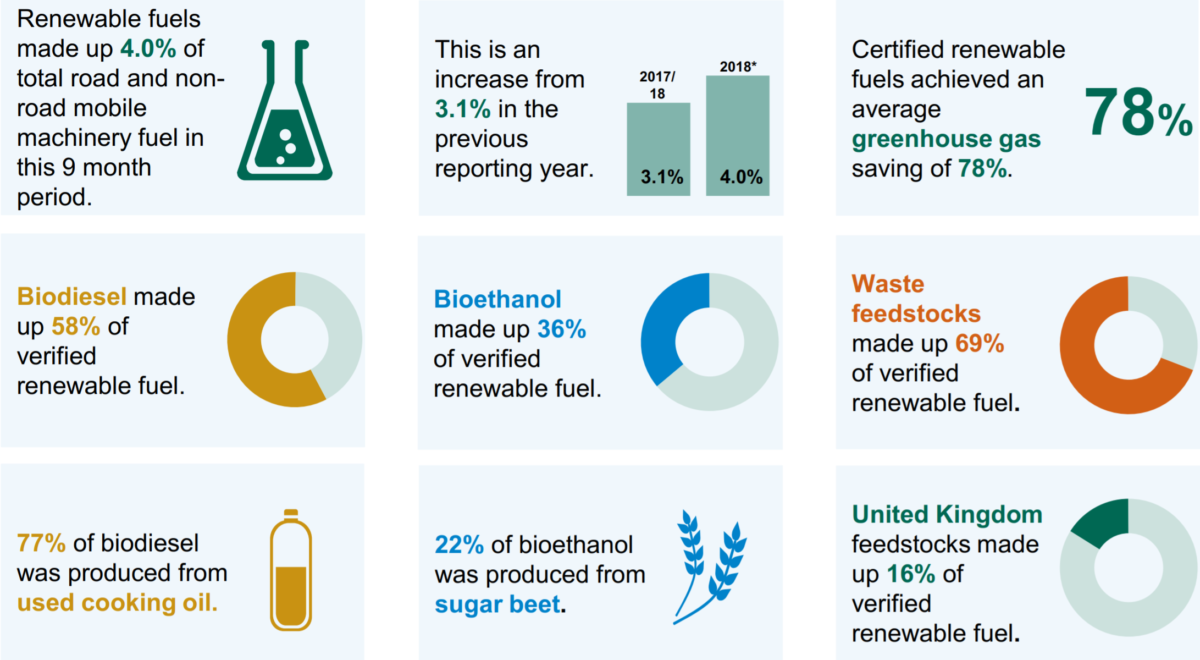 The Renewable Transport Fuel Obligation (RTFO) commenced in 2008 and is one of the Government’s main policies for reducing emissions from fuel for road and non-road mobile machinery (e.g. inland waterway vessels, tractors, and recreational craft, but not aviation). Under the RTFO, fuel suppliers have an obligation to provide a volume of sustainable renewable fuel which is calculated as a proportion of the overall volume of fuel they supply. Government statistics (left) show that over April to December 2018, 1,518 million litres of verified renewable fuel has been supplied, constituting 4% of total road and non-road mobile machinery fuel, an increase from 3.1% in (2017/18).
The Renewable Transport Fuel Obligation (RTFO) commenced in 2008 and is one of the Government’s main policies for reducing emissions from fuel for road and non-road mobile machinery (e.g. inland waterway vessels, tractors, and recreational craft, but not aviation). Under the RTFO, fuel suppliers have an obligation to provide a volume of sustainable renewable fuel which is calculated as a proportion of the overall volume of fuel they supply. Government statistics (left) show that over April to December 2018, 1,518 million litres of verified renewable fuel has been supplied, constituting 4% of total road and non-road mobile machinery fuel, an increase from 3.1% in (2017/18).
There’s clearly a long way to go.
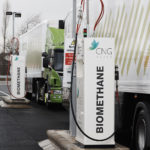 Accredited under the TRFO, CNG Fuels, a heavy vehicle fuelling specialist, will start supplying John Lewis, Asda and Argos with biofuel made from manure sourced from cows and (possibly) humans. Hermes, the first UK carrier to order 100% renewable fuel and electric HGVs, is also interested. The biomethane supplied would be identical to fossil fuel derived compressed natural gas. CNG Fuels is also considering how to use its network of refuelling stations to support hydrogen and electric battery technology for HGVs.
Accredited under the TRFO, CNG Fuels, a heavy vehicle fuelling specialist, will start supplying John Lewis, Asda and Argos with biofuel made from manure sourced from cows and (possibly) humans. Hermes, the first UK carrier to order 100% renewable fuel and electric HGVs, is also interested. The biomethane supplied would be identical to fossil fuel derived compressed natural gas. CNG Fuels is also considering how to use its network of refuelling stations to support hydrogen and electric battery technology for HGVs.
John Lewis currently runs 80 vans on biomethane from food waste, but plans to expand its green fleet and will convert all its trucks to be biomethane-powered by 2028. Using biofuel from food waste reduces the carbon emissions of delivery vans by 85% compared with those running on diesel. However, using manure is considered to be carbon neutral as it helps prevent the release of methane to the atmosphere.
In 2018, Toronto, Canada, the fourth largest city in North America, received an Energy Vision Leadership Award. It is installing new biogas equipment at its waste management facilities which will transform biogas produced from food waste into renewable natural gas. The gas will then be injected into the gas grid, and from March 2020 will be used to power the city’s food waste collection trucks. It is estimated that 10% of the city’s greenhouse gas emissions come from food waste, and this closed-loop system will significantly reduce or negate them, as well as stopping the emission of particulates by not using diesel trucks.
Poo power
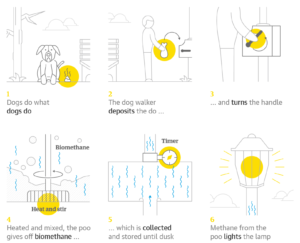 People are exploring using waste and manure in different ways. For example, there is a street lamp powered by the biomethane generated from dog poo in the Worcestershire Area of Outstanding Natural Beauty. Not only is the area now clear of abandoned dog poo bags in hedges, but locals benefits from public lighting (10 bags of poo equate to 2 hours of light).
People are exploring using waste and manure in different ways. For example, there is a street lamp powered by the biomethane generated from dog poo in the Worcestershire Area of Outstanding Natural Beauty. Not only is the area now clear of abandoned dog poo bags in hedges, but locals benefits from public lighting (10 bags of poo equate to 2 hours of light).
The Dutch dairy industry has launched a €150m biogas project to reduce its agricultural emissions, minimise nitrate pollution and contribute to the Netherlands’ target of generating 14% of its energy from renewable sources by the year 2020.
 Yorkshire Water launched “The Number Two Tavern”, the world’s first pub powered by electricity made from poo. This was for a pop-up event in Leeds over 7-9 November 2019 to share knowledge about sustainability and reducing emissions. The water industry have used sewage in anaerobic digesters for decades, and generate ~800 GWh pa of electrical energy from sewage sludge, possibly only half the potential and a quantity that the regulator, Ofwat, wants to increase.
Yorkshire Water launched “The Number Two Tavern”, the world’s first pub powered by electricity made from poo. This was for a pop-up event in Leeds over 7-9 November 2019 to share knowledge about sustainability and reducing emissions. The water industry have used sewage in anaerobic digesters for decades, and generate ~800 GWh pa of electrical energy from sewage sludge, possibly only half the potential and a quantity that the regulator, Ofwat, wants to increase.
A subsidiary of Wessex Water, GENeco, launched the Bio-Bus in 2014, powered by gas from sewage and food waste. It proved a worldwide success, and have been the foundation for 99 bio-buses that will be in action in Bristol by April 2020 by the First West of England bus group, and the opening of a dedicated biomethane bus refuelling station in July 2019.

